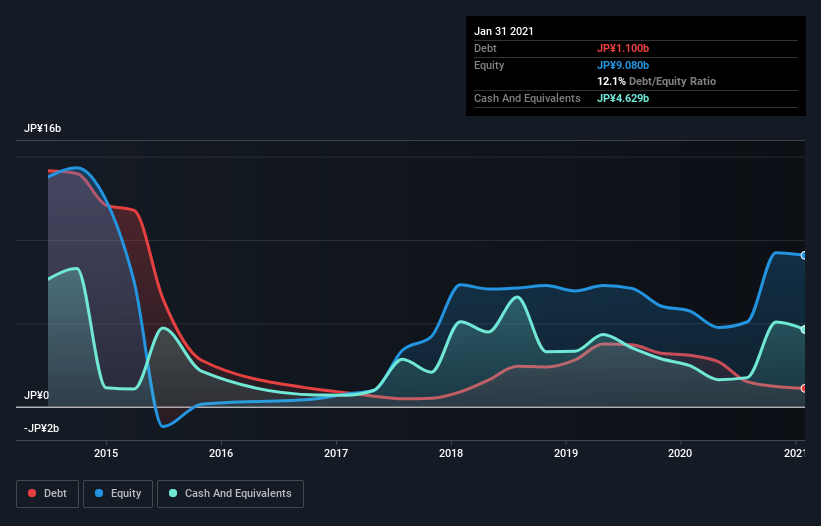Some say volatility, rather than debt, is the best way to think about risk as an investor, but Warren Buffett famously said that 'Volatility is far from synonymous with risk.' When we think about how risky a company is, we always like to look at its use of debt, since debt overload can lead to ruin. As with many other companies CAICA Inc. (TYO:2315) makes use of debt. But the more important question is: how much risk is that debt creating?
What Risk Does Debt Bring?
Debt and other liabilities become risky for a business when it cannot easily fulfill those obligations, either with free cash flow or by raising capital at an attractive price. If things get really bad, the lenders can take control of the business. However, a more frequent (but still costly) occurrence is where a company must issue shares at bargain-basement prices, permanently diluting shareholders, just to shore up its balance sheet. Having said that, the most common situation is where a company manages its debt reasonably well - and to its own advantage. When we examine debt levels, we first consider both cash and debt levels, together.
Check out our latest analysis for CAICA
What Is CAICA's Debt?
The image below, which you can click on for greater detail, shows that CAICA had debt of JP¥1.10b at the end of January 2021, a reduction from JP¥3.08b over a year. However, it does have JP¥4.63b in cash offsetting this, leading to net cash of JP¥3.53b.

A Look At CAICA's Liabilities
We can see from the most recent balance sheet that CAICA had liabilities of JP¥990.0m falling due within a year, and liabilities of JP¥823.0m due beyond that. On the other hand, it had cash of JP¥4.63b and JP¥759.0m worth of receivables due within a year. So it can boast JP¥3.58b more liquid assets than total liabilities.
This state of affairs indicates that CAICA's balance sheet looks quite solid, as its total liabilities are just about equal to its liquid assets. So while it's hard to imagine that the JP¥222.2b company is struggling for cash, we still think it's worth monitoring its balance sheet. Simply put, the fact that CAICA has more cash than debt is arguably a good indication that it can manage its debt safely. When analysing debt levels, the balance sheet is the obvious place to start. But it is CAICA's earnings that will influence how the balance sheet holds up in the future. So when considering debt, it's definitely worth looking at the earnings trend. Click here for an interactive snapshot.
In the last year CAICA had a loss before interest and tax, and actually shrunk its revenue by 24%, to JP¥5.6b. That makes us nervous, to say the least.
So How Risky Is CAICA?
By their very nature companies that are losing money are more risky than those with a long history of profitability. And we do note that CAICA had an earnings before interest and tax (EBIT) loss, over the last year. And over the same period it saw negative free cash outflow of JP¥695m and booked a JP¥454m accounting loss. Given it only has net cash of JP¥3.53b, the company may need to raise more capital if it doesn't reach break-even soon. Overall, its balance sheet doesn't seem overly risky, at the moment, but we're always cautious until we see the positive free cash flow. The balance sheet is clearly the area to focus on when you are analysing debt. However, not all investment risk resides within the balance sheet - far from it. These risks can be hard to spot. Every company has them, and we've spotted 3 warning signs for CAICA (of which 2 are concerning!) you should know about.
If, after all that, you're more interested in a fast growing company with a rock-solid balance sheet, then check out our list of net cash growth stocks without delay.
When trading CAICA or any other investment, use the platform considered by many to be the Professional's Gateway to the Worlds Market, Interactive Brokers. You get the lowest-cost* trading on stocks, options, futures, forex, bonds and funds worldwide from a single integrated account. Promoted
New: AI Stock Screener & Alerts
Our new AI Stock Screener scans the market every day to uncover opportunities.
• Dividend Powerhouses (3%+ Yield)
• Undervalued Small Caps with Insider Buying
• High growth Tech and AI Companies
Or build your own from over 50 metrics.
This article by Simply Wall St is general in nature. It does not constitute a recommendation to buy or sell any stock, and does not take account of your objectives, or your financial situation. We aim to bring you long-term focused analysis driven by fundamental data. Note that our analysis may not factor in the latest price-sensitive company announcements or qualitative material. Simply Wall St has no position in any stocks mentioned.
*Interactive Brokers Rated Lowest Cost Broker by StockBrokers.com Annual Online Review 2020
Have feedback on this article? Concerned about the content? Get in touch with us directly. Alternatively, email editorial-team (at) simplywallst.com.
About TSE:2315
Flawless balance sheet with acceptable track record.
Market Insights
Community Narratives



